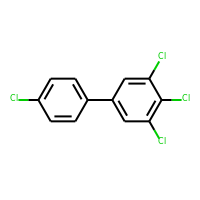
3,4,4',5-Tetrachlorobiphenyl
| Predicted Absorption properties | |||
|---|---|---|---|
| Property | Tool | Interpretation | Probability/Value |
| Caco-2 permeability | pkCSM | High | 1.654 cm/s |
| Human Intestinal Absorption | pkCSM | High | 88.92 % |
| SwissADME | Low | - | |
| Log Kp (Skin permeation) | pkCSM | Low | -1.932 cm/h |
| SwissADME | - | -3.37 cm/s | |
| P-glycoprotein substrate | pkCSM | No | - |
| SwissADME | No | - | |
| vNN | No Prediction | - | |
| P-glycoprotein inhibitor | vNN | No Prediction | - |
| P-glycoprotein inhibitor I | pkCSM | No | - |
| P-glycoprotein inhibitor II | pkCSM | No | - |
| Predicted Distribution properties | |||
|---|---|---|---|
| Property | Tool | Interpretation | Probability/Value |
| Blood Brain Barrier | pkCSM | Yes | 0.347 logBB |
| SwissADME | No | - | |
| vNN | No Prediction | - | |
| CNS permeability | pkCSM | Yes | -1.214 logPS |
| Fraction unbound in human | pkCSM | - | 0 |
| Steady state volume of distribution (VDss) | pkCSM | High | 0.578 L/Kg |
| Predicted Metabolism properties | |||
|---|---|---|---|
| Property | Tool | Interpretation | Probability/Value |
| CYP1A2 inhibitor | pkCSM | Yes | - |
| SwissADME | Yes | - | |
| vNN | No Prediction | - | |
| CYP2C19 inhibitor | pkCSM | Yes | - |
| SwissADME | Yes | - | |
| vNN | No Prediction | - | |
| CYP2C9 inhibitor | pkCSM | Yes | - |
| SwissADME | Yes | - | |
| vNN | No Prediction | - | |
| CYP2D6 inhibitor | pkCSM | No | - |
| SwissADME | No | - | |
| vNN | No Prediction | - | |
| CYP2D6 substrate | pkCSM | No | - |
| CYP3A4 inhibitor | pkCSM | No | - |
| SwissADME | No | - | |
| vNN | No | - | |
| CYP3A4 substrate | pkCSM | Yes | - |
| Human Liver Microsomal (HLM) stability assay | vNN | No Prediction | - |
| Predicted Excretion properties | |||
|---|---|---|---|
| Property | Tool | Interpretation | Probability/Value |
| Renal OCT2 substrate | pkCSM | No | - |
| Total clearance | pkCSM | - | 0.184 ml/min/kg |
DISCLAIMER
ExHuMId is a knowledgebase compiled through manual curation of published scientific literature wherein environmental contaminants were detected in human milk samples across India. We are not responsible for any errors in published scientific articles from where the human milk exposome specific to India was compiled. We are also not responsible for any omission of published scientific articles containing information on human milk exposome specific to India. Importantly, our primary goal to build this resource was to enable future research on human exposome studies specific to India. Hence, the views expressed in this work are solely based on our scientific understanding of the topic, and they do not necessarily reflect the views or policies of our employers or funders.